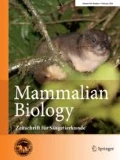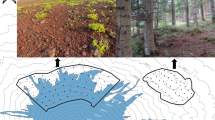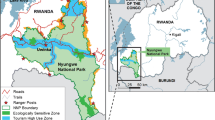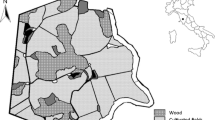Abstract
Determining the environmental factors that contribute to food resource partitioning or overlap is key to understanding the mechanisms of multispecies coexistence. Two ruminants, the Japanese serow (Capricornis crispus) and the sika deer (Cervus nippon), occur sympatrically in Japan, and interspecific interactions between them regarding food resource utilization remain unclear. In this study, we compared the diets of these two sympatric ungulates in two contrasting habitats: a montane forest and an alpine grassland in Mt. Asama. The montane forest provides both broad-leaved trees and graminoids of relatively small quantity, while the alpine grassland provides abundant graminoids. In the montane forest, the serow fed mainly on dicot leaves while the deer fed mainly on graminoids, suggesting partitioning of food resources. By contrast, in the alpine grassland, both species fed mainly on graminoids, resulting in dietary overlap. These results suggest that these two species can partition food resources in habitats with diverse food resources, while their diets tend to overlap in habitats with simple food resource composition. Their coexistence was seemingly facilitated by food resource partitioning in the montane forest and by sharing abundant food in the alpine grassland, suggesting that competition between them is unlikely at this location.




Similar content being viewed by others
References
Asakura G, Kaneshiro Y, Takatsuki S (2014) A comparison of the fecal compositions of sympatric populations of sika deer and Japanese serows on Mt. Sanrei in Shikoku, southwestern Japan. Mammal Study 39:129–132. https://doi.org/10.3106/041.039.0201
Azorit C, Tellado S, Oya A, Moro J (2012) Seasonal and specific diet variations in sympatric red and fallow deer of southern Spain: a preliminary approach to feeding behaviour. Anim Prod Sci 52:720–727. https://doi.org/10.1071/AN12016
Baba M, Doi T, Kawano J, Shimizu T (1997) Utilization pattern of latrines in Japanese serow, Capricornis crispus. Bull Kitakyushu Mus Nat Hist Hum Hist 16:105–111 (in Japanese)
Bagchi S, Goyal SP, Sankar K (2003) Niche relationships of an ungulate assemblage in a dry tropical forest. J Mammal 84:981–988. https://doi.org/10.1644/BBa-024
Bates D, Maechler M, Bolker B, Walker S (2015) Fitting linear mixed-effects models using lme4. J Stat Softw 67:1–48. https://doi.org/10.18637/jss.v067.i01
Bell RH (1971) A grazing ecosystem in the Serengeti. Sci Am 225:86–93. https://doi.org/10.1038/scientificamerican0771-86
Bodmer RE (1991) Influence of digestive morphology on resource partitioning in Amazonian ungulates. Oecologia 85:361–365. https://doi.org/10.1007/BF00320611
Campos-Arceiz A, Takatsuki S (2005) Food habits of sika deer in the Shiranuka Hills, eastern Hokkaido: a northern example from the north–south variations in food habits in sika deer. Ecol Res 20:129–133. https://doi.org/10.1007/s11284-004-0019-4
Chessel D, Dufour AB, Thioulouse J (2004) The ade4 package - I: one-table methods. R News 4:5–10
Corlatti L, Bonardi A, Bragalanti N, Pedrotti L (2019) Long-term dynamics of Alpine ungulates suggest interspecific competition. J Zool 309:241–249. https://doi.org/10.1111/jzo.12716
de Boer WF, Prins HH (1990) Large herbivores that strive mightily but eat and drink as friends. Oecologia 82:264–274. https://doi.org/10.1007/BF00323544
Endo Y, Takada H, Takatsuki S (2017) Comparison of the food habits of the sika deer (Cervus nippon), the Japanese serow (Capricornis crispus), and the wild boar (Sus scrofa), sympatric herbivorous mammals from Mt. Asama, central Japan. Mammal Study 42:131–140. https://doi.org/10.3106/041.042.0303
Ferretti F, Corazza M, Campana I, Pietrocini V, Brunetti C, Scornavacca D, Lovari S (2015) Competition between wild herbivores: reintroduced red deer and Apennine chamois. Behav Ecol 26:550–559. https://doi.org/10.1093/beheco/aru226
Ferretti F, Lovari S, Stephens PA (2019) Joint effects of weather and interspecific competition on foraging behavior and survival of a mountain herbivore. Curr Zool 65:165–175. https://doi.org/10.1093/cz/zoy032
Festa-Bianchet M (1998) Condition-dependent reproductive success in bighorn ewes. Ecol Lett 1:91–94. https://doi.org/10.1046/j.1461-0248.1998.00023.x
Gordon I, Illius A (1989) Resource partitioning by ungulates on the Isle of Rhum. Oecologia 79:383–389. https://doi.org/10.1007/BF00384318
Hashimoto Y, Mori Y (2017) Transition in the distribution of the Japanese serow in the Suzuka Mountains Japanese serow protection area. Wildlife Human Soc 5:1–8. https://doi.org/10.20798/awhswhs.5.2_1 (in Japanese)
Hofmann RR (1973) The ruminant stomach. Stomach structure and feeding habits of East African game ruminants. East African monographs in biology. Vol. 2. E.A. Lit. Bureau, Nairobi
Jarman PJ (1974) The social organisation of antelope in relation to their ecology. Behaviour 48:215–267. https://doi.org/10.1163/156853974X00345
Jarman PJ, Sinclair ARE (1979) Feeding strategy and the pattern of resource partitioning in ungulates. In: Sinclair ARE, Norton-Griffiths M (eds) Serengeti: dynamics of an ecosystem. University of Chicago Press, Chicago, Illinois, pp 130–163
Jass CN, Mead JI (2004) Capricornis crispus. Mamm Species 750:1–10. https://doi.org/10.1644/750
Jenkins K, Wright R (1988) Resource partitioning and competition among cervids in the northern Rocky Mountains. J Appl Ecol 25:11–24. https://doi.org/10.2307/2403606
Jiang Z, Torii H, Takatsuki S, Ohba T (2008) Local variation in diet composition of the Japanese serow during winter. Zool Sci 25:1220–1226. https://doi.org/10.2108/zsj.25.1220
Kagamiuchi Y, Takatsuki S (2020) Diets of sika deer invading Mt Yatsugatake and the Japanese South Alps in the alpine zone of central Japan. Wildl Biol. https://doi.org/10.2981/wlb.00710
Kishimoto R, Kawamichi T (1996) Territoriality and monogamous pairs in a solitary ungulate, the Japanese serow, Capricornis crispus. Anim Behav 52:673–682. https://doi.org/10.1006/anbe.1996.0212
Kobayashi K, Takatsuki S (2012) A comparison of food habits of two sympatric ruminants of Mt. Yatsugatake, central Japan: sika deer and Japanese serow. Acta Theriol 57:343–349. https://doi.org/10.1007/s13364-012-0077-x
Latham J (1999) Interspecific interactions of ungulates in European forests: an overview. Forest Ecol Manag 120:13–21. https://doi.org/10.1016/S0378-1127(98)00539-8
Li Z, Jiang Z, Li C (2008) Dietary overlap of Przewalski’s gazelle, Tibetan gazelle, and Tibetan sheep on the Qinghai-Tibet Plateau. J Wildl Manag 72:944–948. https://doi.org/10.2193/2007-233
Lovari S, Ferretti F, Corazza M, Minder I, Troiani N, Ferrari C, Saddi A (2014) Unexpected consequences of reintroductions: competition between reintroduced red deer and Apennine chamois. Anim Conserv 17:359–370. https://doi.org/10.1111/acv.12103
Maesako Y, Takatsuki S (2015) Threats of sika deer and the future of Japanese forests—effectiveness and limits of deer-proof fences for vegetation conservation. Bun-ichi Shuppan Co, Tokyo (in Japanese)
Mishra C, Van Wieren SE, Ketner P, Heitkönig IM, Prins HH (2004) Competition between domestic livestock and wild bharal Pseudois nayaur in the Indian Trans-Himalaya. J Appl Ecol 41:344–354. https://doi.org/10.1111/j.0021-8901.2004.00885.x
Mysterud A (2000) Diet overlap among ruminants in Fennoscandia. Oecologia 124:130–137. https://doi.org/10.1007/s004420050032
Nagaike T (2012) Effects of browsing by sika deer (Cervus nippon) on subalpine vegetation at Mt. Kita, central Japan. Ecol Res 27:467–473. https://doi.org/10.1007/s11284-011-0917-1
Nagata J (2015) Cervus Nippon (Temminck, 1836). In: Ohdachi DS, Ishibashi Y, Saitoh T, Fukui D, Saitoh T (eds) The wild mammals of Japan, 2nd edn. Shoukadoh Book Sellers and the Mammalogical Society of Japan, Kyoto, pp 304–306
Ochiai K (1999) Diet of the Japanese serow (Capricornis crispus) on the Shimokita Peninsula, northern Japan, in reference to variations with a 16-year interval. Mammal Study 24:91–102. https://doi.org/10.3106/mammalstudy.24.91
Ochiai K (2015) Capricornis crispus (Temminck, 1836). In: Ohdachi DS, Ishibashi Y, Saitoh T, Fukui D, Saitoh T (eds) The wild mammals of Japan, 2nd edn. Shoukadoh Book Sellers and the Mammalogical Society of Japan, Kyoto, pp 314–317
Ochiai K (2016) The Japnese serow: behavior and ecology of a solitary ungulate. University of Tokyo Press, Tokyo (in Japanese)
Ochiai K, Susaki K (2002) Effects of Territoriality on Population Density in the Japanese Serow (Capricornis crispus). J Mammal 83:964–972. https://doi.org/10.1644/1545-1542(2002)083%3c0964:EOTOPD%3e2.0.CO;2
Ohashi H, Yoshikawa M, Oono K, Tanaka N, Hatase Y, Murakami Y (2014) The impact of sika deer on vegetation in Japan: setting management priorities on a national scale. Environ Manage 54:631–640. https://doi.org/10.1007/s00267-014-0326-7
Ohtaishi N (1986) Preliminary memorandum of classification, distribution and geographical variation on Sika deer. Honyurui Kagaku 53:13–17. https://doi.org/10.11238/mammalianscience.26.2_13 (in Japanese)
Pettorelli N, Pelletier F, Hardenberg AV, Festa-Bianchet M, Côté SD (2007) Early onset of vegetation growth vs. rapid green-up: impacts on juvenile mountain ungulates. Ecology 88:381–390. https://doi.org/10.1890/06-0875
Pianka ER (1974) Niche overlap and diffuse competition. Proc Natl Acad Sci USA 71:2141–2145. https://doi.org/10.1073/pnas.71.5.2141
Prins HH, De Boer WF, van Oeveren H, Correia A, Mafuca J, Olff H (2006) Coexistence and niche segregation of three small bovid species in southern Mozambique. Afr J Ecol 44:186–198. https://doi.org/10.1111/j.1365-2028.2006.00619.x
Putman R (1996) Competition and resource partitioning in temperate ungulate assemblies. Chapman & Hall, London
R Core Team (2017) R: a language and environment for statistical computing. R Foundation for Statistical Computing, Vienna. Available from: https://www.R-project.org/. Accessed 1 October 2020
Sietses DJ, Faupin G, de Boer WF, de Jong CB, Henkens RJ, Usukhjargal D, Batbaatar T (2009) Resource partitioning between large herbivores in Hustai National Park, Mongolia. Mamm Biol 74:381–393. https://doi.org/10.1016/j.mambio.2009.04.001
Stewart D (1967) Analysis of plant epidermis in faeces: a technique for studying the food preferences of grazing herbivores. J Appl Ecol 4:83–111. https://doi.org/10.2307/2401411
Storms D, Aubry P, Hamann J, Saïd S, Fritz H, Saint-Andrieux C, Klein F (2008) Seasonal variation in diet composition and similarity of sympatric red deer Cervus elaphus and roe deer Capreolus capreolus. Wildl Biol 14:237–250. https://doi.org/10.2981/0909-6396(2008)14[237:SVIDCA]2.0.CO;2
Takada H (2018) Behavioral ecology of a solitary ungulate, Japanese serow (Capricornis crispus) at Mt. Asama, central Japan. Dissertation, Azabu University
Takada H, Minami M (2019a) Food habits of the Japanese serow (Capricornis crispus) in an alpine habitat on Mount Asama, central Japan. Mammalia 83:455–460. https://doi.org/10.1515/mammalia-2018-0099
Takada H, Minami M (2019b) Do differences in ecological conditions influence grouping behaviour in a solitary ungulate, the Japanese serow? Behaviour 156:245–264. https://doi.org/10.1163/1568539X-00003540
Takada H, Washida A (2020) Ecological drivers of group size variation in sika deer: habitat structure, population density, or both? Mammalian Biology 100:445–452. https://doi.org/10.1007/s42991-020-00041-x
Takada H, Minami M (2021) Open habitats promote female group formation in a solitary ungulate: the Japanese serow. Behav Ecol Sociobiol 75. https://doi.org/10.1007/s00265-021-02999-1
Takada H, Nakamura K, Watanabe H, Minami M (2020a) Spatial organization and mating behavior of the Japanese serow under a low population density. Mammalia 84:219–226. https://doi.org/10.1515/mammalia-2019-0045
Takada H, Ohuchi R, Watanabe H, Yano R, Miyaoka R, Nakagawa T, Zenno Y, Minami M (2020b) Habitat use and the coexistence of the sika deer and the Japanese serow, sympatric ungulates from Mt. Asama, central Japan. Mammalia 84:503-511. https://doi.org/10.1515/mammalia-2019-0150
Takahashi K, Uehara A, Takatsuki S (2013) Food habits of sika deer at Otome Highland, Yamanashi, with reference to Sasa nipponica. Mammal Study 38:231–234. https://doi.org/10.3106/041.038.0302
Takatsuki S (1983) The importance of Sasa nipponica as a forage for sika deer (Cervus nippon) in Omote-Nikko. Jap J Ecol 33:17–25. https://doi.org/10.18960/seitai.33.1_17
Takatsuki S (1986) Food habits of sika deer on Mt. Goyo, northern Honshu. Ecol Res 1:119–128. https://doi.org/10.1007/BF02347015
Takatsuki S (2003) Use of mires and food habits of sika deer in the Oze Area, central Japan. Ecol Res 18:331–338. https://doi.org/10.1046/j.1440-1703.2003.00558.x
Takatsuki S (2009a) Effects of sika deer on vegetation in Japan: a review. Biol Conserv 142:1922–1929. https://doi.org/10.1016/j.biocon.2009.02.011
Takatsuki S (2009b) Geographical variations in food habits of sika deer: the northern grazer vs. the southern browser. In: McCullough DR, Takatsuki S, Kaji K (eds) Sika deer. Springer, Tokyo, pp 231–237
Takatsuki S (2010) On the “Biomass Index” for quantitative evaluation of plant communities in wildlife habitats: a proposal. J Azabu Univ 19(20):1–24 (in Japanese)
Takatsuki S, Ikeda S (1993) Botanical and chemical composition of rumen contents of Sika deer on Mt Goyo, northern Japan. Ecol Res 8:57–64. https://doi.org/10.1007/BF02348607
Takatsuki S, Suzuki K (1984) Status and food habits of Japanese serow. In: Hoefs M (ed) Proceedings of the Biennial Symposium of the Northern Wild Sheep and Goat Council 4. Whitehorse, Montana, pp. 231–240
Takatsuki S, Kanomata K, Suzuki K (1981) Defecation rates of sika deer and Japanese serow. Jap J Ecol 31:435–439. https://doi.org/10.18960/seitai.31.4_435 (in Japanese)
Takatsuki S, Fuse S, Ito T (2010) A comparison of diet and digestion between sika deer and Japanese serow in northern Japan. Mammal Study 35:257–263. https://doi.org/10.3106/041.035.0405
Ueda H, Takatsuki S, Takahashi Y (2002) Bark stripping of hinoki cypress by sika deer in relation to snow cover and food availability on Mt Takahara, central Japan. Ecol Res 17:545–551. https://doi.org/10.1046/j.1440-1703.2002.00513.x
Van Soest PJ (1982) Nutritional ecology of the ruminant. O & B Books, Corvallis
Yamashiro A, Kamada M, Yamashiro T (2013) A comparative study of the fecal characters of Japanese serow (Capricornis crispus) and sika deer (Cervus nippon). Mammal Study 38:117–122. https://doi.org/10.3106/041.038.0207
Yamashiro A, Kaneshiro Y, Kawaguchi Y, Yamashiro T (2019) Dietary overlap but spatial gap between sympatric Japanese serow (Capricornis crispus) and sika deer (Cervus nippon) on Eastern Shikoku, Japan. Mammal Study 44:1–7. https://doi.org/10.3106/ms2018-0072
Yokoyama M, Kaji K, Suzuki M (2000) Food habits of sika deer and nutritional value of sika deer diets in eastern Hokkaido, Japan. Ecol Res 15:345–355. https://doi.org/10.1046/j.1440-1703.2000.00355.x
Acknowledgements
Fieldwork was facilitated by the Kazankan of Komoro city government; K. Kanda and other staff members assisted us in the field. Yuko Fukue (NPO Earthworm), Tsuyoshi Takeshita (Komoro City Government), and the staff of the Tengu spa Asama helped us conduct field work. Haruko Watanabe, Nozomu Ogawa, Hiroaki Chikakiyo, Riki Ohuchi, and Akane Washida of Azabu University helped with fieldwork. We thank Gabe Yedid PhD, from Edanz Group (https://en-author-services.edanzgroup.com/ac) for editing a draft of this manuscript. This work was supported by a research Project Grant awarded by the Cooperative Research Program of the Wildlife Research Center of Kyoto University (Kyoto), and by the Pro Natura Foundation Japan’s 26th Pro Natura Fund (Tokyo).
Funding
This work was supported by a research Project Grant awarded by the Cooperative Research Program of the Wildlife Research Center of Kyoto University (Kyoto), and by the Pro Natura Foundation Japan’s 26th Pro Natura Fund (Tokyo).
Author information
Authors and Affiliations
Contributions
HT contributed to the study conception and design. Material preparation, data collection, and microscopic analysis were performed by RY, AK, and ST. Statistical analysis was performed by HT. The first draft of the manuscript was written by HT and all authors commented on previous versions of the manuscript. All authors read and approved the final manuscript.
Corresponding author
Ethics declarations
Conflict of interest
Not applicable.
Ethical approval
All investigation was performed in accordance with the Ethics Committee for Animal Experiments, Mount Fuji Research Institute, Yamanashi Prefecture Government (ECAE-01-2013-2019).
Consent to participate
Not applicable.
Consent for publication
Not applicable.
Availability of data and materials
The data that support the findings of this study are available from the corresponding author upon reasonable request.
Code availability
Not applicable.
Additional information
Publisher's Note
Springer Nature remains neutral with regard to jurisdictional claims in published maps and institutional affiliations.
Handling editor: Luca Corlatti.
Rights and permissions
About this article
Cite this article
Takada, H., Yano, R., Katsumata, A. et al. Diet compositions of two sympatric ungulates, the Japanese serow (Capricornis crispus) and the sika deer (Cervus nippon), in a montane forest and an alpine grassland of Mt. Asama, central Japan. Mamm Biol 101, 681–694 (2021). https://doi.org/10.1007/s42991-021-00122-5
Received:
Accepted:
Published:
Issue Date:
DOI: https://doi.org/10.1007/s42991-021-00122-5




